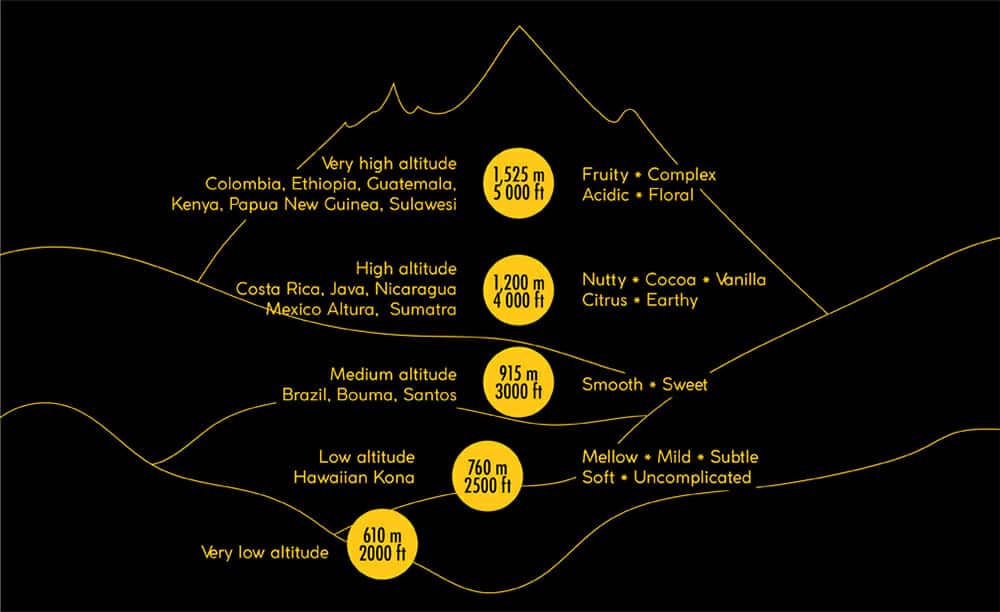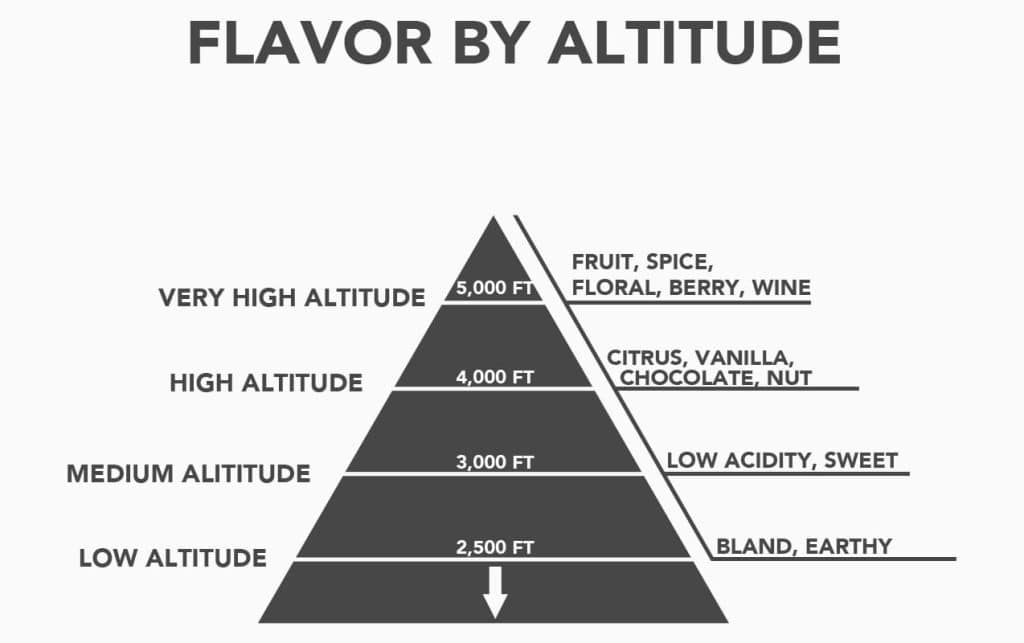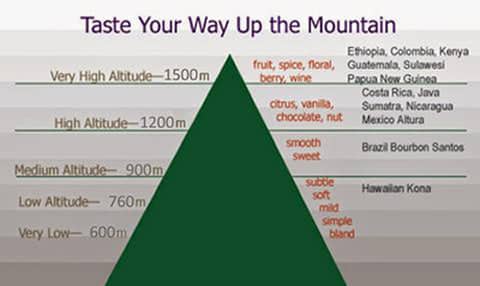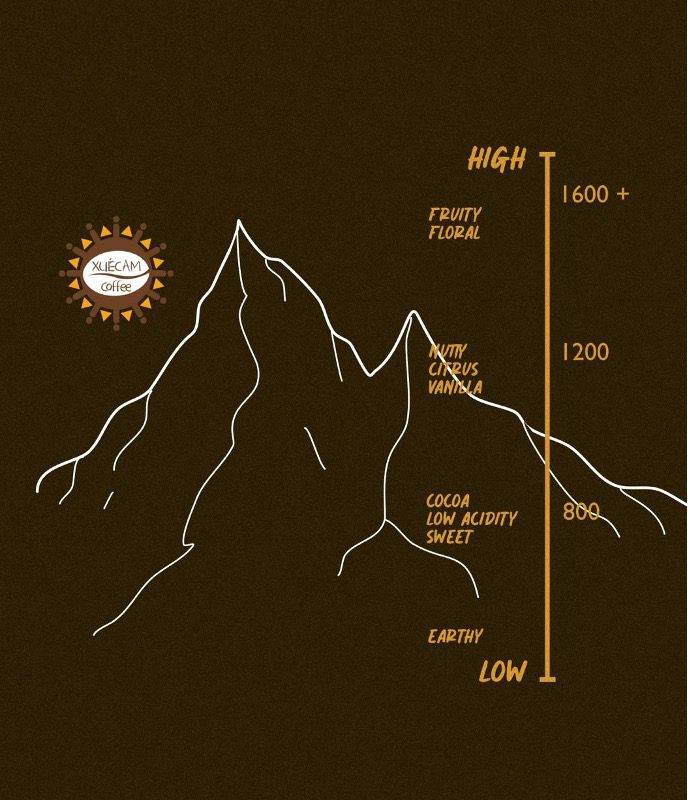In the dynamic world of coffee, the altitude of coffee plantations plays a crucial role in determining the flavor profiles of our beloved brew.
Whether it’s the high mountain farms or the lowland estates, each altitude brings unique characteristics that shape the taste we savor in every sip.
Journey with us as we explore the fascinating relationship between altitude and coffee flavor, uncovering the secrets hidden within the bean’s growth and elevation.
Discover how altitude elevates your coffee experience to new heights.
Flavor Profile of Coffee
Coffee is renowned for its complex and diverse flavor profile, offering a wide range of sensory experiences to coffee lovers.
Various factors, including altitude, temperature, air pressure, sunlight exposure, bean development, biodiversity, soil quality, coffee varietals, and harvesting and processing techniques, influence the flavor of coffee. Understanding how these factors contribute to the flavor of coffee is essential in appreciating and enjoying different coffee flavors.
What factors contribute to the flavor of coffee?
Several factors play a crucial role in shaping the flavor of coffee. Altitude, temperature, air pressure, sunlight exposure, bean development, biodiversity, and soil quality are critical factors contributing to coffee’s unique flavor profile. By analyzing and understanding these factors, coffee connoisseurs and professionals can better appreciate the nuances of coffee flavors.
Why is flavor an essential aspect of coffee?
Flavor is a critical coffee aspect that enhances the coffee-drinking experience. The flavor profile of coffee encompasses various taste notes, aromas, body, acidity, and sweetness.
It is through the distinct flavors that coffee enthusiasts can distinguish between different coffee beans, regions, and processing methods. The complexity and richness of coffee flavors also enable individuals to explore and discover new sensory delights, making coffee drinking an enjoyable and immersive experience.
What are the different flavor notes found in coffee?
Coffee possesses a wide range of flavor notes that can be categorized into various profiles. Some standard flavor notes in coffee include fruity, nutty, chocolatey, floral, spicy, earthy, and caramel.
Each coffee bean and origin may exhibit different flavor characteristics, ranging from the bright and vibrant acidity of citrus fruits to the smooth and velvety taste of chocolate. The diversity in flavor notes allows coffee drinkers to find their preferred flavor profiles and appreciate the unique qualities of different coffees.
Altitude and its Impact
Altitude plays a significant role in coffee cultivation and profoundly impacts coffee’s flavor profile. Understanding how altitude affects coffee beans and flavor development is crucial for evaluating and appreciating coffee quality.
What is considered a high altitude for coffee cultivation?
High altitude for coffee cultivation is typically classified as altitudes above 1,200 meters (4,000 feet) above sea level. Coffee plants face specific environmental conditions that significantly influence their growth and flavor development at these elevations.
How does altitude affect coffee beans?
Altitude affects coffee beans in various ways. Coffee plants grown at higher altitudes receive less oxygen and undergo slower maturation. This extended maturation period produces denser, harder beans with more complex flavors. Additionally, the reduced air pressure at higher altitudes alters the plant metabolism, impacting the composition of sugars and organic acids within the beans.
In what ways does altitude impact flavor development?
Altitude has a direct impact on flavor development in coffee. Coffee cherries grow at higher altitudes and undergo a slower maturation process. This slow development allows the beans to accumulate more sugars, enhancing sweetness and subtle acidity. Altitude also influences the overall cup profile, affecting the balance between acidity, body, and aroma.
Which flavor elements are influenced by altitude?
The flavors influenced by altitude vary depending on the specific growing region and coffee varietal. However, altitude generally affects the coffee flavor’s acidity, sweetness, and complexity.
Higher altitudes produce coffee with brighter acidity and increased floral and fruity notes. The sweetness is often intensified, and the complexity of flavors becomes more pronounced, offering a multidimensional cup profile that coffee enthusiasts highly sought after.
Temperature and Climate
Temperature and climate are closely tied to altitude and significantly impact coffee plants’ growth and flavor development. Understanding the relationship between temperature, climate, and coffee flavor is crucial in evaluating and appreciating the unique qualities of coffee grown at different altitudes.
How does temperature vary with altitude?
Temperature decreases with increasing altitude. As coffee is predominantly grown in tropical regions, the climate becomes more relaxed and temperate at higher elevations. This temperature drop influences coffee plants’ physiological processes, affecting their growth, bean development, and flavor composition.
What climatic conditions are found at high altitudes?
High-altitude regions often exhibit cooler temperatures, reduced humidity, and increased cloud cover. These climatic conditions at higher elevations create a more controlled environment for coffee cultivation, allowing for slower bean development and the preservation of flavor-enhancing compounds.
What role does temperature play in flavor development?
Temperature plays a crucial role in flavor development by influencing the biochemical reactions within coffee beans. Cooler temperatures at higher altitudes slow the metabolic process, allowing the beans to develop more complex flavors. Additionally, the lower temperature preserves the volatile aromatic compounds, contributing to the rich aroma and fragrance found in high-altitude coffees.
Why do cooler temperatures at higher altitudes enhance flavor?
Cooler temperatures at higher altitudes enhance flavor by extending the ripening process of the coffee beans. This gradual maturation allows the sugars within the beans to develop fully, resulting in a naturally sweeter cup of coffee. Furthermore, cooler temperatures slow the breakdown of organic acids, leading to a well-balanced acidity that complements the overall flavor profile.
Air Pressure and Oxygen Levels
Air pressure and oxygen levels significantly impact coffee plants’ growth and flavor development. Exploring the relationship between altitude, air pressure, and flavor formation is crucial in understanding the distinctive qualities of coffee grown at different elevations.
How does air pressure change at different altitudes?
Air pressure decreases with increasing altitude. This decrease in atmospheric pressure affects the physiological processes of coffee plants, including the uptake and distribution of nutrients and the synthesis of flavor compounds within the beans.
What is the effect of reduced air pressure on coffee plants?
The reduced air pressure at higher altitudes affects coffee plants in several ways. It slows down the metabolic rate, reducing organic acid production and altering sugar metabolism. The lower air pressure also limits the release of volatile aromatic compounds during the roasting process, resulting in a more delicate and nuanced aroma.
Why do higher elevations result in lower oxygen levels?
Higher elevations result in lower oxygen levels due to decreased air pressure. As coffee plants depend on oxygen for various metabolic processes, the reduced oxygen availability affects their growth, development, and flavor composition.
However, this lower oxygen environment contributes to high-altitude coffees’ unique flavors and characteristics.
How does reduced oxygen contribute to flavor formation?
The reduced oxygen levels at higher altitudes contribute to flavor formation by modifying the metabolic pathways of coffee plants.
The limited oxygen availability slows down the breakdown of organic acids, promoting the development of brighter acidity in the cup. This altered metabolism also influences the accumulation of sugars and flavor compounds, imparting unique and complex flavors to the coffee beans.
Sunlight Exposure
Sunlight exposure is a crucial factor in coffee cultivation, influencing coffee plants’ growth, maturation, and flavor development. Understanding the impact of sunlight exposure on coffee flavor is essential in appreciating the complexities and nuances of different coffee beans.
Does sunlight intensity increase or decrease with altitude?
Sunlight intensity decreases with altitude. At higher elevations, the atmospheric conditions and cloud cover reduce coffee plants’ direct sunlight exposure. This reduced sunlight intensity has significant implications for coffee’s growth and flavor development.
How does sunlight exposure influence coffee flavor?
Sunlight exposure influences coffee flavor by affecting the photosynthesis process in the coffee plants’ leaves.
The intensity and duration of sunlight exposure directly impact the carbon fixation rate and the accumulation of sugars in the beans. The balance between sunlight and shade allows for optimal flavor development, with varying levels of sunlight exposure contributing to the complexity of flavors in different coffee beans.
What are the effects of prolonged sun exposure at different altitudes?
Prolonged sun exposure at different altitudes influences coffee flavor in distinct ways. In higher altitude regions, the cooler temperatures and reduced sun exposure result in slow bean development and extended maturation.
This prolonged exposure allows the beans to accumulate sugars gradually, contributing to enhanced sweetness and complexity in the cup. In contrast, lower altitude regions with intense sun exposure may produce coffee beans with bolder and more pronounced flavors.
In what ways does sunlight impact the acidity and sweetness of coffee?
Sunlight plays a vital role in shaping the acidity and sweetness of coffee. The intensity and duration of sunlight exposure influence the production and accumulation of organic acids, such as malic and citric acids.
Coffee plants can produce higher acidity levels with adequate sunlight, resulting in bright and vibrant flavors. Additionally, sunlight exposure promotes the synthesis of sugars, contributing to the sweetness and balance of the final cup.
Slow Bean Development
Bean development at high altitudes occurs at a slower pace compared to lower altitude regions. This unique characteristic impacts the flavor profile of coffee, resulting in distinctive taste notes that coffee enthusiasts highly sought after.
Why does bean development slow down at higher altitudes?
Bean development slows down at higher altitudes primarily due to the cooler temperatures and reduced oxygen levels.
The combination of these factors extends the maturation period of the coffee cherries, allowing for the gradual accumulation of sugars and flavor compounds within the beans. This prolonged development process contributes to the depth and complexity of flavors found in high-altitude coffees.
What are the benefits of slow bean development?
The slow bean development process offers several benefits in terms of coffee flavor. The extended maturation allows the beans to develop a greater complexity of flavors, with enhanced sweetness, acidity, and aroma.
The slower growth rate also contributes to the denser and harder beans, resulting in a more desirable cup profile that showcases the unique qualities of the particular coffee varietal and growing region.
How does extended maturation affect the flavor of coffee?
Extended maturation affects the flavor of coffee by allowing additional time for the accumulation of sugars, organic acids, and other flavor compounds.
This prolonged development process adds depth and complexity to the coffee, resulting in a more intricate and balanced flavor profile. Extended maturation also contributes to high-quality coffee’s desirable nuances and characteristics.
Which specific flavors develop during the extended maturation?
Specific flavors develop in coffee beans grown at high altitudes during the extended maturation process. The slow development allows for the gradual accumulation of sweetness, resulting in flavors reminiscent of caramel, chocolate, and ripe fruits.
The extended maturation period also enhances the acidity, presenting bright and vibrant notes such as citrus, berry, or wine-like characteristics. The prolonged development time also allows for the formation of subtle floral and herbal flavors, adding complexity and depth to the overall cup profile.
Biodiversity and Soil Quality
Biodiversity and soil quality are vital aspects of coffee cultivation, influenced by altitude. The interplay between altitude, biodiversity, and soil quality significantly impacts coffee beans’ flavor development.
How does altitude affect biodiversity in coffee-growing regions?
Altitude has a direct impact on the biodiversity of coffee-growing regions. Higher altitudes generally present harsher environmental conditions, such as cooler temperatures and reduced oxygen availability.
These conditions limit biodiversity, favoring specific species adapted to thrive under these circumstances. Consequently, high-altitude coffee-growing regions often exhibit lower biodiversity but with a unique mix of plant and animal species that contribute to the overall ecosystem.
What influence does biodiversity have on coffee flavor?
Biodiversity plays a crucial role in coffee flavor development. Diverse flora and fauna within coffee-growing regions contribute to the overall health and balance of the ecosystem, which ultimately affects the growth and flavor of coffee plants.
The interaction between coffee plants, shade trees, insects, birds, and other organisms influences pollination, soil health, nutrient cycling, and pest control. These factors collectively contribute to the coffee beans’ unique flavor characteristics and terroir.
What role does soil quality play in the flavor development process?
Soil quality is a vital factor in the flavor development process of coffee. High-quality soils provide essential nutrients and minerals to coffee plants, enabling optimal growth and nutrient absorption.
Nutrient-rich soils enhance the flavor complexity of coffee by promoting healthy plant development, encouraging the synthesis of sugars, and influencing the uptake of flavor compounds from the soil. The unique composition of high-altitude soils contributes to coffee’s distinctive flavors and characteristics at higher elevations.
Why do higher altitudes often result in nutrient-rich soils?
Higher altitudes often result in nutrient-rich soils due to various geological and environmental factors. The erosion process in mountainous regions contributes to the deposition of mineral-rich sediments in the lower-lying areas, including coffee-growing regions.
Furthermore, cooler temperatures and reduced microbial activity at higher elevations result in slower nutrient decomposition, allowing nutrients to accumulate in the soil. These nutrient-rich soils provide the necessary elements for healthy plant growth and flavor development.
Varietal-Specific Responses
Different coffee varietals exhibit varied responses to altitude, further influencing the flavor profile and quality of the beans. Understanding how altitude affects specific coffee varietals is essential in appreciating their unique characteristics.
Do different coffee varietals react differently to altitude?
Yes, different coffee varietals react differently to altitude. Each coffee varietal possesses distinct genetic characteristics and adaptations that influence its response to altitude. Some varietals thrive at high altitudes, while others may not perform as well.
By understanding the specific reactions of different varietals to altitude, coffee producers can optimize their cultivation methods and achieve superior flavor profiles.
How does altitude affect the flavor profile of Arabica coffee?
Altitude significantly impacts the flavor profile of Arabica coffee. Arabica plants grown at higher altitudes typically exhibit increased complexity, acidity, and sweetness in flavor profiles.
The extended maturation process, cooler temperatures, and reduced oxygen levels at higher elevations contribute to developing unique flavor notes often associated with high-quality Arabica coffees.
What are the unique characteristics of Robusta coffee at high altitudes?
Robusta coffee, while generally associated with lower altitudes, can also be grown at higher elevations.
The cultivation of Robusta at high altitudes can result in unique characteristics such as enhanced sweetness, complex flavor profiles, and improved cup quality. The slower maturation and cooler temperatures at these altitudes allow Robusta beans to develop flavors that transcend the traditional perception of Robusta coffee.
Are there varietals suited explicitly for high-altitude cultivation?
Yes, specific coffee varietals are particularly suited for high-altitude cultivation. Varietals such as Typica, Bourbon, and Gesha have demonstrated exceptional adaptability and flavor development at higher elevations.
These varietals often produce coffees with intricate and nuanced flavor profiles, showcasing the unique qualities of the specific origin and elevational conditions.
Harvesting and Processing Challenges
Harvesting and processing coffee at high altitudes present unique challenges due to environmental conditions and logistical constraints. Understanding these challenges and their impact on the final flavor is essential for coffee producers and consumers.
What challenges are faced during coffee harvesting at high altitudes?
Coffee harvesting at high altitudes presents challenges in terms of accessibility, labor efficiency, and quality control. The steep terrains and remote locations of high-altitude farms make it challenging to navigate and transport harvested cherries.
Additionally, the cooler temperatures and slower maturation process delay the ripening of coffee cherries, increasing the harvesting window and labor requirements. Ensuring the timely and selective harvesting of fully ripe cherries is crucial for optimal flavor development.
How does the processing of coffee cherries differ at various altitudes?
The processing of coffee cherries can differ at various altitudes due to environmental conditions and logistical considerations. At higher altitudes, cooler temperatures may prolong the drying and fermentation stages of processing.
This extended processing time can contribute to developing unique flavor characteristics and enhance the overall cup quality. However, it also requires careful monitoring and control to prevent negative impacts on the final product.
What impact do these challenges and differences have on the final flavor?
The challenges and differences in harvesting and processing at high altitudes can have a significant impact on the final flavor of coffee.
Proper harvesting techniques and selective hand-picking of fully ripe cherries are crucial to ensure the extraction of optimal flavors.
Slower drying and fermentation processes at higher altitudes can contribute to developing more complex and nuanced flavors. However, mishandling or delays during these processes can result in off-flavors or defects that negatively impact the cup’s quality.
Are there any specific processing techniques developed for high-altitude coffee?
Coffee producers and processors have developed specific techniques to address the challenges of high-altitude cultivation. Some standard techniques include shade drying car,eful fermentation time, and temperature control.
These techniques optimize drying and enhance the desired flavor characteristics specific to high-altitude coffee. Additionally, innovative approaches in post-harvest processing, such as controlled fermentation and extended fermentation periods, are being explored to elevate the flavor complexity of high-altitude coffees further.
Cupping and Tasting Rituals
Cupping, a standardized method of evaluating coffee, plays a significant role in the coffee industry.
Understanding the influence of altitude on cupping procedures and the existence of altitude-specific tasting preferences or certifications is crucial in appreciating and recognizing the quality of coffee.
What is the significance of cupping in the coffee industry?
Cupping is a globally recognized and standardized method of evaluating coffee. It involves observing the aroma, tasting the flavors, and assessing the overall quality and characteristics of the coffee beans.
Cupping provides a structured framework for assessing and comparing different coffees, allowing for objective evaluations of flavor, acidity, body, and other sensory qualities.
How does altitude impact the cupping procedures?
Altitude impacts cupping procedures by introducing a variable that influences the flavor characteristics of coffee.
Cupping sessions for different altitudes may involve specific protocols, such as separating coffee samples by altitude or adjusting brewing parameters to cater to distinct flavor profiles.
These procedures ensure that specific altitudes’ unique qualities and nuances are appropriately evaluated and appreciated during the cupping ess.
Whrences or standards exist for altitude-specific coffee tasting?
Preferences and standards for altitude-specific coffee tasting depend on various factors, including regional preferences and individual preferences of coffee professionals.
Some coffee enthusiasts may prefer the nuanced flavors and enhanced sweetness of high-altitude coffees, while others may favor the bold and robust flavors of lower-altitude beans.
Additionally, specific certifications, such as specialty coffee certifications, may have specific grading criteria and quality standards that acknowledge the influence of altitude on flavor profile.
Are there any notable altitude-specific coffee competitions or certifications?
Yes, there are notable altitude-specific coffee competitions and certifications that recognize the unique qualities and flavors associated with specific altitudes.
The Cup of Excellence competition, for example, showcases exceptional coffees from different origins, including high-altitude regions.
Additionally, specialty coffee certifications, such as those provided by the Specialty Coffee Association, often consider altitude a significant factor in evaluating and certifying coffees of exceptional quality.
In conclusion, the altitude of coffee plantations plays a pivotal role in shaping the flavor profile of coffee.
Factors such as temperature, air pressure, sunlight exposure, bean development, biodiversity, soil quality, coffee varietals, and harvesting and processing techniques contribute to the unique characteristics and complexities of coffee grown at different altitudes.
By understanding and appreciating the influence of altitude on coffee flavor, coffee enthusiasts can deepen their enjoyment and exploration of the diverse world of coffee.
Whether savoring the bright acidity and floral notes of high-altitude Arabica beans or relishing the bold flavors of lower-altitude Robusta, the altitude-specific flavors of coffee offer a delightful and rich sensory experience.




































